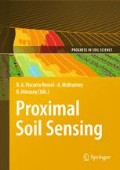Abstract
Electromagnetic induction sensors, such as the Geonics EM38, are used widely for monitoring and mapping soil attributes via the apparent electrical conductivity (ECa) of the soil. The sensor response is the depth-integrated combination of the depth–response function of the EM38 and the local electrical conductivity ECa(z). In deep Vertosols, assuming that the depth–response function is not perturbed by the soil and that the volumetric moisture content θ(z) dominates ECa(z), the EM38 should be capable of predicting θ(z). A multi-height EM38 experiment was conducted over deep Vertosols to confirm the validity of the EM38 depth–response function, to test the hypothesis that the EM38 response was an additive combination of its depth–response function and θ(z), and to investigate if on-ground ECa measurements could estimate average θ within the root zone. A simple model, involving mathematical summation of measured θ(z) from sectioned ‘calibration cores’ and the EM38’s known depth–response function, was found to explain 87 and 83% of the variance in measured ECa for both horizontal and vertical dipole configurations, respectively. This included all data acquired at multiple sensor heights above the ground. However, a subsequent comparison of on-ground, EM38-derived ECa and average θ from surface to 0.8 m (\(\bar \theta _{{\textrm{0}}{\textrm{.8}}}\)) and surface to 1.2 m (\(\bar \theta _{{\textrm{1}}{\textrm{.2}}}\)) demonstrated that \(\bar \theta _{{\textrm{0}}{\textrm{.8}}}\) and \(\bar \theta _{{\textrm{1}}{\textrm{.2}}}\) explained only 37 and 46% of the variance in ECa for vertical dipole configuration measurements, compared to 55 and 56% of the variance for horizontal dipole configuration measurements. This result can be attributed to the small depth-specific changes in the ECa(z) and θ(z) relationship and the limited proportion of the depth–response function of the EM38 interacting with the soil volumes investigated. Whereas the best calibration over these depth ranges was achieved using a horizontal dipole configuration, further improvements in both dipole orientations might be achieved by calibrating, then deploying, the sensors while they are elevated tens of centimetres above the ground.
Access this chapter
Tax calculation will be finalised at checkout
Purchases are for personal use only
References
Borchers B, Uram T, Hendrickx JMH (1997) Tikhonov regularization of electrical conductivity depth profiles in field soils. Soil Sci Soc AM J 61:1004–1009
Brevik EC, Fenton TE, Lazari A (2006) Soil electrical conductivity as a function of soil water content and implications for soil mapping. Precision Agric 7:393–404
Hendrickx JMH, Borchers B, Corwin DL, Lesch SM, Hilgendorf AC, Schlue J (2002) Inversion of soil conductivity profiles from electromagnetic induction measurements: theory and experimental verification. Soil Sci Soc Am J 66:673–685
Hezarjaribi A, Sourell H (2007) Feasibility study of monitoring the total available water content using non-invasive electromagnetic induction-based and electrode based soil electrical conductivity measurements. Irrigat Drainage 56:53–65
Hossain MB (2008) EM38 for measuring and mapping soil moisture in a cracking clay soil. PhD thesis, University of New England, Australia
Kachanoski RG, Gregorich EG, Van Wesenbeck IJ (1988) Estimating spatial variations of soil water content using noncontacting electromagnetic inductive methods. Can J Soil Sci 68:715–722
Lide DR (ed) (2007) CRC handbook of chemistry and physics, 88th edn. CRC Press, London
Marshall WL (1987) Electrical conductance of liquid and supercritical water evaluated at 0°C and 0.1 MPa to high temperatures and pressures: reduced state relationships. J Chem Eng Data 32:221–226
McBratney AB, Minasny B, Whelan BM (2005) Obtaining ‘useful’ high-resolution soil data from proximally sensed electrical conductivity/resistivity (PSEC/R) surveys. In: Stafford JV (ed) Precision agriculture ‘05. Wageningen Academic Publishers, The Netherlands
McNeill JD (1980) Electromagnetic terrain conductivity measurement at low induction numbers. Technical note TN-6. Geonics Limited, Mississauga, Ontario, Canada
Reedy RC, Scanlon BR (2003) Soil water content monitoring using electromagnetic induction. J Geotech Geoenviron Eng 129:1028–1039
Rhoades JD, Corwin DL (1981) Determining soil electrical conductivity–depth relations using an inductive electromagnetic soil conductivity meter. Soil Sci Soc Am J 45:255–260
Sheets KR, Hendrickx JMH (1995) Non-invasive soil water content measurement using electromagnetic induction. Water Resour Res 31:2401–2409
Acknowledgements
We would like to thank Cate MacGregor and George Henderson for their assistance with field work.
Author information
Authors and Affiliations
Corresponding author
Editor information
Editors and Affiliations
Rights and permissions
Copyright information
© 2010 Springer Science+Business Media B.V.
About this chapter
Cite this chapter
Hossain, M., Lamb, D., Lockwood, P., Frazier, P. (2010). Field Determination of Soil Moisture in the Root Zone of Deep Vertosols Using EM38 Measurements: Calibration and Application Issues. In: Viscarra Rossel, R., McBratney, A., Minasny, B. (eds) Proximal Soil Sensing. Progress in Soil Science. Springer, Dordrecht. https://doi.org/10.1007/978-90-481-8859-8_21
Download citation
DOI: https://doi.org/10.1007/978-90-481-8859-8_21
Published:
Publisher Name: Springer, Dordrecht
Print ISBN: 978-90-481-8858-1
Online ISBN: 978-90-481-8859-8
eBook Packages: Earth and Environmental ScienceEarth and Environmental Science (R0)

